Should a Greenfield filter be removed?
The decision to remove a Greenfield filter, also known as an inferior vena cava (IVC) filter, should be made on a case-by-case basis, taking into consideration the individual patient's medical history, the reason for filter placement, and the potential risks and benefits. Greenfield filters are typically used to prevent blood clots, such as deep vein thrombosis (DVT), from traveling to the lungs, causing a pulmonary embolism. Whether or not to remove the filter is influenced by several factors:
Duration of Protection: IVC filters are often intended for temporary use, especially in situations where there is a temporary risk of blood clots, such as after surgery or trauma. The decision to remove the filter may depend on the duration of protection needed.
Risk of Complications: IVC filters, like all medical devices, carry a risk of complications over time. These complications can include filter migration, perforation, fracture, and thrombosis. The longer a filter remains in place, the greater the risk of these complications.
Patient's Medical Status: A patient's overall health and medical condition can influence the decision to remove an IVC filter. If the patient's risk of pulmonary embolism has subsided, and the filter is no longer necessary, removal may be considered.
Potential for Retrieval: Not all IVC filters are easily retrievable. The design and placement of the filter can affect the feasibility of removal. A healthcare provider will assess whether the filter can be safely retrieved.
Long-Term Protection: In some cases, a patient may require long-term protection against blood clots. In such situations, the healthcare provider may recommend keeping the filter in place, but close monitoring for complications is essential.
Patient Preferences: Patient preferences and their understanding of the risks and benefits play a role in the decision-making process. Patients should be informed about the purpose of the filter and the potential risks associated with its removal or retention.
Ultimately, the decision to remove an IVC filter should be made collaboratively between the patient and their healthcare provider. It should be based on a thorough evaluation of the patient's condition, the necessity of continued protection against blood clots, and the potential risks and benefits associated with filter removal or retention.
If you have an IVC filter and are unsure about whether it should be removed, it is essential to consult with your healthcare provider. They can assess your specific medical situation and provide guidance on the best course of action. In cases where there are concerns about the filter's long-term safety or the need for removal, it may be advisable to seek a second opinion from a specialist or interventional radiologist with expertise in IVC filter management.
Considerations for removing a Greenfield filter
Greenfield filters are a type of inferior vena cava (IVC) filter that are inserted into the IVC to prevent blood clots from traveling to the lungs. However, Greenfield filters can also cause complications, such as filter migration, filter fracture, and filter thrombosis. Therefore, it is important to consider the risks and benefits of Greenfield filter removal before making a decision.
Indications for Greenfield filter removal
There are a number of reasons why a doctor may recommend removing a Greenfield filter, including:
- The filter is no longer needed. For example, if the patient is no longer at risk of developing a blood clot, the filter can be removed.
- The filter is causing complications. If the filter is causing pain, migration, or other problems, it can be removed.
- The patient is undergoing certain medical procedures. For example, if the patient is scheduled for an MRI, the filter may need to be removed.
Risks and benefits associated with Greenfield filter removal
The risks and benefits of Greenfield filter removal vary depending on the individual patient. However, some of the potential risks include:
- Bleeding
- Infection
- Damage to the IVC
- Filter fragments remaining in the body
The potential benefits of Greenfield filter removal include:
- Eliminating the risk of filter-related complications
- Improving the patient's quality of life
The procedure for removing a Greenfield filter
Greenfield filter removal is a minimally invasive procedure that is typically performed under general anesthesia. The surgeon will make a small incision in the groin and insert a catheter into the IVC. The catheter will be guided to the filter, and a snare will be used to capture the filter. The filter will then be removed through the catheter.
Post-removal care and recovery for patients
Most patients are able to go home the same day as their Greenfield filter removal procedure. However, they may need to take blood thinners for a period of time after the procedure to reduce the risk of blood clots.
Patients should also avoid strenuous activity for several weeks after the procedure. They should also follow their doctor's instructions on wound care and bathing.
Conclusion
Greenfield filter removal is a safe and effective procedure for patients who no longer need the filter or who are experiencing complications related to the filter. Patients should discuss the risks and benefits of Greenfield filter removal with their doctor before making a decision.













